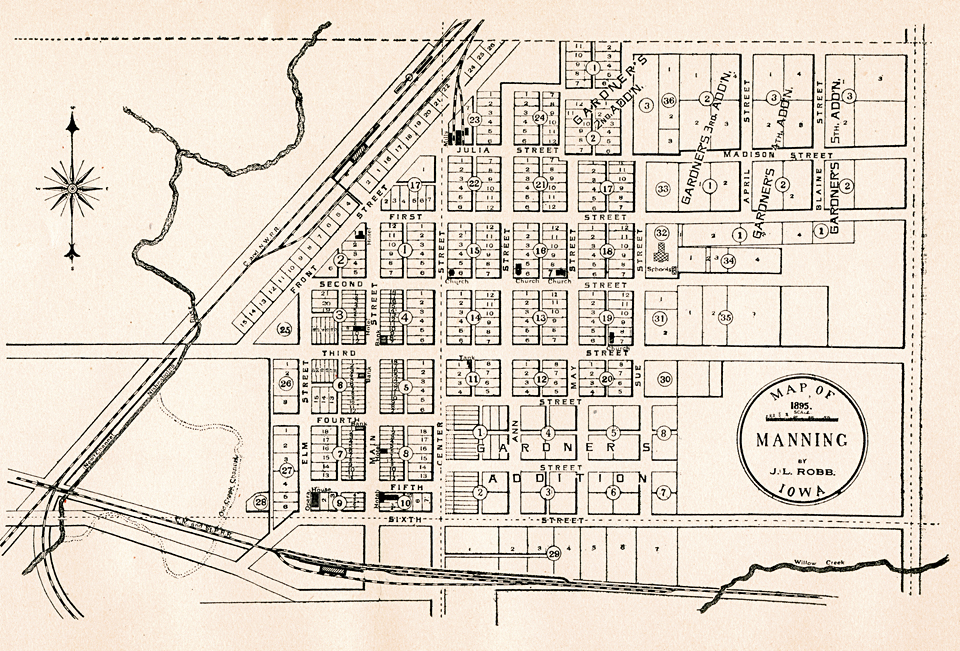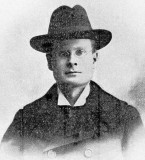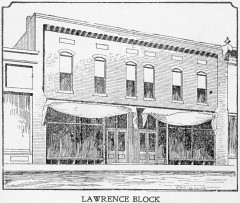
1895 Map of Manning by J. L. Robb


To avoid confusion of lines by the reader I shall use the lines according to the following descriptions irrespective of the Manual of Land Surveying,
Section Lines are those lines which bound a section.
Center Lines or Half Section Lines are those which alone divide the section into halves and by intersection divide the section into quarters,
Quarter Lines are the lines which divide a quarter section into quarter quarters, eigths, or 40 acre tracts.
Eighth Lines are those lines which divide 40 acre tracts into 10 acre lots.
All lines used in descriptions refer to Section 17 and to the south east quarter of the same unless otherwise specified.
THE "Town of MANNING" was surveyed and platted in July, 1881. This survey included all of the east half of the S E 1/4 of Section 17, which lay east of the North Western right of way. The platted part consisted of Blocks 1 to 7 (sub-divided) and Block 8 (not subdivided). It appears that the starting point of the survey was the south half-section post of section 17, and that the south section line of this section was used as a base fine, as the streets and alleys run parallel with, and perpendicular, to this line.
THE "FIRST ADDITION" was laid out November 17th and 18th, 1881, and the lots were placed on sale the week following. This consisted of Blocks 8 to 17, Out Lot "One" and Out Lot "Two". It appears that this addition was laid out with reference to the "Town of Manning", and that the west line of Center Street was used as base line.
THE "WESTERN TOWN LOT COMPANY'S FIRST ADDITION" was laid out June 20th, 1882. This was merely a subdivision of Out Lot "Two" into Blocks 17 to 20 and Out Lot "A". These were laid out with reference to the "First Addition".
THE "'AUDITOR'S SUB-DIVISION of OUT LOTS 'ONE' AND 'A' " into Blocks 21 to 24 and 30 to 34 was made with reference to the "First Addition" and the "Western Town Lot Company's First Addition". All previous sub-divisions of Out Lot "One" were made with reference to these additions.
THE AUDITORS'S SUB-DIVISION of OUT LOT 'A'; - - Etc., into Blocks 25 to 36, was made as follows:
BLOCKS 25 To 28 were laid out with reference to the "Town of Manning": the south side of Section 17 being used as a base.
BLOCK 29 was laid out with reference to Center and Sixth Streets extend: using the north line of Section 20 as a base, and the half section post, of the Same, as a point of commencement.
BLOCKS 30 To 33 were laid out with reference to Out Lot "A" of the "First Addition": it being, merely, a sub-division of the same.
BLOCK 34 was laid out with reference to the north and south half section line. This fine was, also, used as a base, and a point 80 rods east of it and 33 feet north of Second street- extended was established as a point of commencement.
BLOCK 35 was laid out with reference to the north fine of Third Street -extendedand the north and South quarter section line of the south east quarter. The point of commencement was made with reference to the south east corner of Block 19.
BLOCK 36 was laid out with reference to Gardner's Second Addition, and the fractional section fines bounding it.
GARDNER'S ADDITION was laid out independent of the rest of the town. Its base fines are the south section line and the north and south half section line.
GARDNER'S SECOND ADDITION was laid out with the cast and west half section fine as a base, and the center section monument as a tie point for the point of commencement. The descriptions say that the north and south fines run perpendicular to the base line which is an error, they should run parallel with the north and south half section line. This addition should conform with the half, quarter and eighth section lines which bound it. The plat. and description set forth that it contains 660 feet east and west which is an error. It contains only 540 feet.
Gardener's THIRD, FOURTH, AND FIFTH ADDITIONS were laid out with reference to the
north and south quarter section fines of the south east quarter and to the streets and
alleys extended of the adjoining plats on the west. It appears that, through error, the east
and west streets of these additions, when extended, does not coincide with the streets of
the adjoining additions on the west, but veered to the north about 12 feet in 80 rods. This
left a variation in the north block of these additions and also a wedge shaped parcel of
land between them and the blocks and un-platted parcels on the south. This wedge
commenced in the north and south quarter section fine of this quarter and increased in
width till it reached the east section fine.
This parcel is especially noticeable between Blocks 1 of Gardner's Fourth and Fifth
Additions and Block 34.
The "Auditor's Sub division of Out Lots 'One' and 'A' " was filed January 19, 1889.
The "Auditor's Sub-division of Out Lot "A";- - - - etc., into Blocks 21 to 36 was entered
January 23, 1889; Gardner's Addition, October 1, 1881; Gardner's Second Addition, June 20, 1882; Gardner's Third Addition. April 12, 1886; Gardner's Fourth Addition, October 7, 1886; Gardner's Fifth Addition, December 30, 1887.
MONUMENTS are marked on the plats as follows: center section stone: a quarter stone on east and west half section fine, east of center stone; a half section stone in south section line: a stone at south west corner of Block 17 in Out Lot "A"; a stone at intersection of First and May Streets; a stone on south fine of First and in center of Main Streets; a stone at intersection or Main and Fifth Streets; a stone at intersection of Center and Third Streets; and a stone at intersection of Second and Ann Streets.
Owing to the lack of space, it is almost impossible to point out the errors made in the plats on record in the recorder's office. One uninitiated would soon become confused and if he follows the plats he is liable to make a serious error, for some of the errors are self evident on the face of them and others can not be discovered by other means than platting and the comparison of all the records pertaining to the land in this section and verification by the field notes of original and succeeding official surveys.
Up till 1883, Manning had no regular incorporated cemetery association. The land that was set off for the burial of the dead, was located in the north east un-subdivided portion of Out Lot "One" and west part of Block 1 of Gardner's 2nd Addition. This land seems to have been set a side as a temporary burial place. In 1883 the agitation of a permanent cemetery was taken up and an association formed.

The following committee was appointed to select the grounds and arrange for purchasing and laying out the same: W. F. Howard, U. S. Heffelfinger, J. M. Turner and William Laughery. By June of 1884 the bodies were moved from the old and re-interred in the new cemetery. In May 1884 an ordinance was enacted prohibiting the burial of the dead in the incorporated limits, and providing for the removal of the same. Previous to this, private lots in different parts of town had been used for burial places, but this was now done away with, principally for sanitary purposes.
The ground that was selected, was purchased of the Manning Driving Park association, and lay south of the old fair grounds. It contained the south 1/8 of the SW 1/4of the NE 1/4of Section 20.
In 1895, the demand for lots necessitated the extension of the cemetery further south as the land adjoining on this side was more desirable than that which adjoined it on the north or east. The new addition lies on the north side of the N. W. 1/4 of the S. E. 1/4 of section 20, and has an area nearly equal to that of the old cemetery.

In February of 1891, a number of ladies organized a society at the Presbyterian church, for the purpose of beautifying the cemetery and raising enough money to build a sidewalk from the town out to the same. The officers elected were. Mrs. Julia Ives, Pres.; Sara Arney, Vice Pres.; Clara Reed Sec.; Sarah L. Garrett, Ties. Their first entertainment was given in May of the same year. This and a number of other similar entertainments netted the association, with outside assistance, sufficient money to build the sidewalk and make some very much needed improvements.
It is strange that a town of this size, and possessing its wealth and energy can not continue the good work, and pride themselves in showing, at least, as nice and well kept cemetery as can be found elsewhere in this or any of the neighboring counties. If the proper interest is manifested it costs but little more to keep a cemetery in a neat, tasty condition, than it does, to half keep it.
Up to August 2nd 1881, there was little or nothing in the way of building, that would indicate the site of a future city. Three and a half months later we find, what was but a short time before a common farm yard, now a thriving little city supporting the following business firms and enterprises, as chronicled in the Manning Monitor, Vol. 1, No. 1, bearing the date, November 17, 1881. Entering the town from the north on the North-western, the attention of the visitor is attracted by the extensive yard the company has laid out and lengthy switches; the substantial section house and out built for the maintenance of the road and the accommodation of business, while the depot, which is a building two stories high, furnishes good accommodation for the traveling public and a comfortable home for the agent, E. C. Wilbur and his family.
The first upon the list of business houses is the grain ware house of Bell & Winter, standing on the south siding near the depot. In the same locality will be found the lumber yards of the Green Bay Lumber Company and that of John Dierks. The third lumber yard is that of Wolfe & Nodle on the west side of Main Street. On lot 6, Block 3, is located the Garfield House built and operated by W. M. Tingle & Son. This building is 18 by 48 feet and two stories high, with a basement.
Adjoining this is the millinery store of Mrs. G. M. Dailey. Next door
is E. B. Wilson the harness maker and saddler. The largest building
in town is that belonging to Callison who occupies the front for tonsorial and bath
rooms while the rear, which is 24 by 60 feet, is used as a hall.
The next building to Callison's, after a vacant lot, is the Farmers and Traders Bank,
in the rear of which building is the Monitor office. On the corner of Main and Third
Streets, in the same block, is the restaurant and confectionary of A. Young.
Across Third Street south is the hardware store of Wetherill & Morsh. Adjoining them is the general store of Callamore & Priest. Heinzman Bros. & Moody will soon occupy the large store building adjoining Callamore & Priest. Whealen Bros. was the first firm on the ground coming with their grocery stock about the first of April. Next comes Stocker's Meat Market which is joined on the opposite side by Fred Gestenberg who runs the loudest saloon in the business and has the largest building in the place. He also runs a lunch room in connection with the saloon. Passing a vacant lot you find the Post Office which is kept by Seth Smith. Next to the Post Office is McQuaid while a new building adjoining on the south and belonging to L. M. Freelove will be occupied as a restaurant. The last building on this block, and facing Fourth and Main Streets, is a two story frame structure belonging to Engleman. Crossing Fourth Street south, we step into Shunters Meat Market adjoining which is the Farmers Home kept by Fred Huber. The machine shop is on the south of this. Next to this is the paint shop of Burley & Brown.
Funk Bros. have a nice stock of clothing and furnishing goods, Hoffmann & Schoop have just opened a stock of dry goods and groceries on one side of their building, and furniture and sewing machines on the other side. Tidd & Foote run an extensive blacksmithing business on the corner of Main and Fifth Streets.
Returning to the east side of Main Street, we have, first the general store of Benson & Vauhn. Chapman Bros., next door, have just arrived with a splendid assortment of dry goods. Barber & Turner are building a large drugstore opposite the Post Office. Martin & Launderville, hardware, is next in line with Lathrop's restaurant adjoining. Next come the saloons of W. E. Heitman and John Marks. Dr. T. S. McKenna has an office on Main Street opposite Callimore & Priest. Mr. Barber is erecting a fine two story building on the corner of Main and Third Streets. On the opposite side of Third Street is the drug store of L. S. Knox adjoining which is the boarding house and bakery of Miles Woolman.
Mr. Emery has a nice store room near Hensley's boarding house. L. M. Conkling will open a broom factory, where at least two men will be employed. The livery barns of Laughery & Arnold and Gardner & Wilson are on Third Street, and Gaylord's Feed Stable is at the foot of Main Street. Dr. G. M. Barber has located here in the practice of his profession. W. B. Hockett and W. B. Gardner have drug stocks. The law firms are E. B. Blazer and H. S. Fisher.
We trust that the above will assist the reader in locating the various business enterprises and the time that they located here. It also serves to show the rapidity with which the town grew. When we consider the distance that some of the lumber had to be hauled and the newness of the country it is marvelous, the rapidity with which the buildings sprung up, and the prosperity that the town enjoyed in its infancy. Up till September 5th practically all of the building material was hauled overland by teams from Carroll and Arcadia. After this date it was brought from Carroll on the North Western.
The following STATISTICS will serve to show the increase and growth of the town for the
first few months: On November 10, there were not less than 85 substantial buildings, 45 of
which were store buildings and the remainder dwellings. Nearly all of the store buildings
were two stories high, the second story being used as dwellings.
On Saturday, November 5, 1881, E. L. Blazer was employed by the Monitor to take the
first census of the town.
The result was found to be as follows:
The town contained 414 souls.
By Thursday, December 29, 1881, the business portion of Manning had increased to 112 buildings, of which 69 were business blocks and the remainder, 43 were dwellings. The population had increased to 515; 303 males and 225 females. How the ratio has changed.

The increase and changes of Business Firms up to this date are as follows, Freelove
bought wheat, H. Hockett bought corn, Ben Brookfield engaged in a general grain business.
N. F. Spear bought flax seed. Arney Bros. of Albion Ia. had opened a large hardware store
and implement house on Main Street north of Fourth. McQuaid had taken in a partner
changing the firm name to McQuaid & Hambleton. M. L. Freelove had opened a stock of
groceries and provisions three doors south of the Post Office. J. W. Tinsley of Exira, had
erected a building near the corner of Main and second Streets, which was to be stocked
with drugs.
A wagon and blacksmith shop was erected on Second Street west of Main by
M. Hoffmann. W. M. Fuller had opened a harness shop and stock near the Post Office. Bour of Exira,
had also opened a harness shop on Block 8. Henry Siem had opened
a shop for the saving of soles near Hoffmann & Schoop. L. W. Meyers lathered and
shaved in the building where Wilson's harness shop was located. Ferrall had put in a
meat market. Mrs. Arp was preparing to place a millinery store in Block 8. Boarding
houses increased as did the rest of the enterprises. Miles Woolman had started a flour
and feed exchange.
Among the public improvements was the school and more commodeous accommodations for holding religious services which will be mentioned under their respective heads. From this time on the town displayed the usual push and energy that characterized its citizens who were making the greatest efforts possible, to advance their interests, morally, spiritually, socially and politically as well as financially.

They had contended for and obtained a Post Office, suppressed the saloons and reduced the immorality of the town in general. They had organized Sunday schools, arranged for places of worship, and had held revivals and sociables. They had built halls and held dances and theatricals.
They had held town and school elections, incorporated the town and organized a school system. They had organized bands, Literary societies and agitated a public library. They had organized a fire company for the protection of property and life, and laid out a cemetery for the burial of the dead. All of these had been accomplished in the first year of the towns existence.